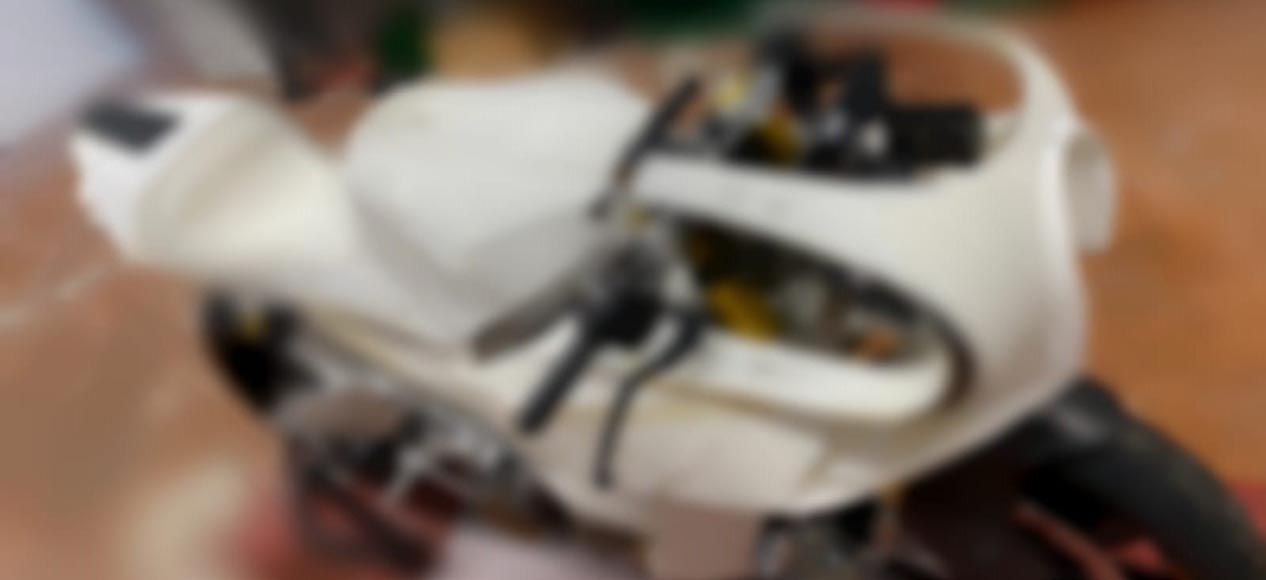Historic Italian boutique manufacturer Bimota looks set for a comeback later this year, as it puts the final touches on its new KB4 ahead of a late 2020 launch.
The company has put out some deliberately blurry photos on its Facebook page showing a bike on a bench. The photos show a bike draped in unpainted white bodywork, with a fairly conventional looking sportsbike rear end combined with a retro styled upper fairing with space for a 1970’s style round headlight. In typical Italo/English, the accompanying caption adds ‘we get there! Not yet perfectly in focus…’.
Like many Italian factories, Bimota has just reopened after a period of closure enforced by Covid-19 and they’ve used the opportunity to tease their new model, which could well be unveiled in its final form by the end of the year.
The KB4 is expected to be a retro styled machine powered by Kawasaki’s 1043cc Z1000 motor. The swoopy fairing would appear to owe something to the last Kawasaki powered Bimota, the Z1000J-powered KB3 of 1983, and marks the first production model of the Italian company’s collaboration with Kawasaki, which purchased a 49% share in the firm last year. The new company demonstrated a Tesi H2 concept bike featuring Kawasaki’s supercharged H2 Ninja engine, at last year’s Milan motorcycle show, but the KB4 is expected to be a full production model, which is likely to go on sale through Kawasaki’s retail network.
Why Bimota is a big deal?
Bimota may have been something of a novelty manufacturer over the past two decades, but that wasn’t always the case.
In the late 1970s and early 1980s, Bimota made the poster bikes of a generation. At that time, Japanese manufacturers were making fantastically powerful and reliable four-cylinder engines for their range topping superbikes – but chassis technology had remained very much in the back seat.
Formed in 1973 by Valerio Bianchi, Giuseppe Morri and Massimo Tamburini, who each donated the first two letters of their surname to form the word ‘Bimota’ they started out building frames for road and racing.
What Bimota did was to take engines from the likes of the Honda CB750 and Kawasaki Z1, and to put them in race developed chassis with fairings and typically futuristic styling. Early bikes were sold as chassis kits but most of the wealthy buyers of Bimota road bikes bought them as fully built machines from the Rimini factory. They also remained involved in racing, providing the frame for 350cc Grand Prix world champion Jon Ekerold’s Yamaha. They also won the 1987 Formula One world title and the following year won the first ever world superbike race, both with Virginio Ferrari riding Yamaha-powered machines. Along with Switzerland’s Egli, the Bimota name continues to conjure up memories for kids of a certain age, who grew up reading motorcycle magazines and collecting Top Trumps cards.
Bimota went on a natural decline by the mid-1980s, when the Japanese manufacturers started to fit fairings and improve the chassis on their range topping sports bikes. Suddenly models like the Yamaha FZ750 and Suzuki GSX-R750 offered most of the performance and handling of a Bimota for a fraction of the cost. Bimota’s approach was to develop more novel products to justify their premium price tags and the 1990s saw the introduction of the Tesi, with its unusual hub-centre steering system, and the ill-fated V-Due of 1997 – the 500cc two-stroke which used the company’s first (and so far only) in-house engine. The V-twin engine featured a novel fuel-injection system and was so unreliable and rough running that it brought the company down. Bimota ended up refunding disgruntled V Due customers and buying back the bikes. That led to bankruptcy in 2000 – the year Anthony Gobert took the company’s last race win with a surprising victory in a wet world superbike round in Australia on the Suzuki TL1000-powered SB8K.
The most recent incarnation of the company went bankrupt in 2017 but the new company, with near 50% investment from Kawasaki, looks to reverse nearly two decades of turmoil.
Bimota naming conventions
The KB4 designation demonstrates a clear lineage for the latest Bimota. With the exception of the hub centre steered models, which always carry the Tesi name, and the V Due (translated as V Two) with its inhouse engine design, Bimota model names are made up of the initial of the donor engine brand (H for Honda, S for Suzuki etc.) followed by ‘B’ for Bimota and a number to designate which model it is in the series – so KB4 represents the fourth Bimota model to be powered by a Kawasaki engine, while the SB6 (the most common Bimota built with 1144 examples) was the sixth Bimota design to use a Suzuki powerplant, in this case the early 1990s GSX-R1100 unit.



